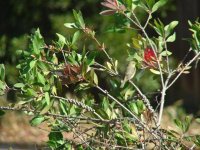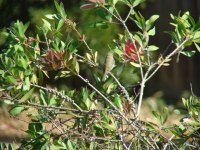Thanks again, everyone.
And enjoyed your gallery, Gentoo. I have the time (for the first time ever!) this year to pay close attention to the birds around my house. My "heritage" coast live oak had to come down last November, because it was diseased and dangerous. It was huge and had been in the yard for >80 years, and sheltered my entire back yard and was a landing spot for falcons and hawks. But now I can see all of the sky, overhead lines, and surrounding trees, and so the smaller birds are much more observable. In the course of being addicted to following the course of my backyard Cali towhee nest and emerging babies, I have seen and learned to name the OC warbler, bushtits, European starlings, house finches (beautiful), house sparrow, and probably a white-crowned sparrow, in addition to the usual obvious mockingbirds, hummingbirds, crows, pigeons, and lovely doves (they are also nesting in my yard). I'm wondering where all the jays have gone. They were everywhere until about a month ago.





